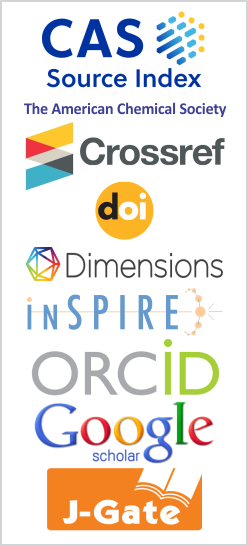Coherent Population Trapping in An Inhomogeneously Broadened \(\Lambda\)-System with Multiple Excited States
DOI:
https://doi.org/10.26713/jamcnp.v3i2.464Keywords:
Coherent population trapping, Doppler-broadened system, Transparency window, Absorption and multiple excited statesAbstract
We present a theoretical model using density matrix approach to study the phenomenon of coherent population trapping (CPT) in the \(\Lambda\)-type Doppler broadened system with multiple excited states. A multi-level \(\Lambda\)-system is formed by considering the closely spaced hyperfine levels in the D2 line of \(^{87}\)Rb. The presence of closely spaced hyperfine levels affects the transparency window and cause asymmetry in absorption profiles. We observe the sharp CPT dip when the frequency difference of applied fields is equal to the frequency separation between two ground levels. This dip demonstrates that the system is trapped in the dark state. By performing a thermal averaging in the Doppler-broadened \(\Lambda\)-system, we have shown that the transparency window becomes narrower and its linewidth decreases at higher temperature. This study has potential applications in precision measurements due to the small linewidth of the transparency window.
Downloads
References
K.-J. Boller, A. Imamoglu and S.E. Harris, Observation of electromagnetically induced transparency, Phys. Rev. Lett. 66 (1991), 2593-2596.
M. Fleischhauer, A. Imamoglu and J.P. Marangos, Electromagnetically induced transparency: optics in coherent media, Rev. Mod. Phys. 77 (2005), 633-673.
B. Lounis and C. Cohen-Tannoudji, Coherent population trapping and fano profiles, J. Phys. II France 2 (1992), 579-592.
E. Arimondo, Coherent population trapping in laser spectroscopy, Progress in Optics XXXV (1996), 257-354.
J. Mompart and R. Carbálan, Lasing without inversion, J. Opt. B: Quantum Semiclass Opt. 2 (2000), R7-R24.
S.A. Zibrov, I. Novikova, D.F. Phillips, R.L. Walsworth, A.S. Zibrov, V.L. Velichansky, A.V. Taichenachev and V.I. Yudin, Coherent-population trapping resonances with linearly polarized light for all-optical miniature atomic clocks, Phys. Rev. A 81 (2010), 013833.
M.O. Scully and M. Fleischhauer, High-sensitivity magnetometer based on index-enhanced media, Phys. Rev. Lett. 69 (1992), 1360.
A. Aspect, E. Arimondo, R. Kaiser, N. Vansteenkiste and C. Cohen-Tannoudji, Laser coolingg below the one-photon recoil energy by velocity-selective coherent population trapping, Phys. Rev. Lett. 61 (1988), 826.
A. Hemmerich, M. Weidemüer, T. Esslinger, C. Zimmermann and T. Hänsch, Trapping atoms in a dark optical lattice, Phys. Rev. Lett. 75 (1995), 37.
M. Auzinsh, D. Budker and S.M. Rochester, Optically Polarized Atoms, Oxford University Press (2010).
C. Santori et al., Coherent population trapping of single spins in diamond under optical excitation, Phys. Rev. Lett. 97 (2006), 247401 (4p).
P. Kaur, V. Bharti and Ajay Wasan, Optical properties of an inhomogeneously broadened ¤V-system with multiple excited states, Journal of Modern Optics 16 (2014), 1339-1347.
V. Bharti and Ajay Wasan, Electromagnetic induced transparency in the Doppler broadened cascade transition with multiple excited levels, J. Phys. B: At. Mol. Opt. Phys. 45 (2012), 185501 (9p).
Downloads
Published
How to Cite
Issue
Section
License
Authors who publish with this journal agree to the following terms:- Authors retain copyright and grant the journal right of first publication with the work simultaneously licensed under a CCAL that allows others to share the work with an acknowledgement of the work's authorship and initial publication in this journal.
- Authors are able to enter into separate, additional contractual arrangements for the non-exclusive distribution of the journal's published version of the work (e.g., post it to an institutional repository or publish it in a book), with an acknowledgement of its initial publication in this journal.
- Authors are permitted and encouraged to post their work online (e.g., in institutional repositories or on their website) prior to and during the submission process, as it can lead to productive exchanges, as well as earlier and greater citation of published work.




